Taxation Law
VerifiedAdded on 2023/03/30
|7
|1262
|404
AI Summary
This document provides an in-depth analysis of taxation law, including the definition of an Australian resident and the sources of income. It also discusses the main residence exemption and provides case studies on the taxation of government grants and sponsorships. The document includes references to relevant court cases and legislation.
Contribute Materials
Your contribution can guide someone’s learning journey. Share your
documents today.
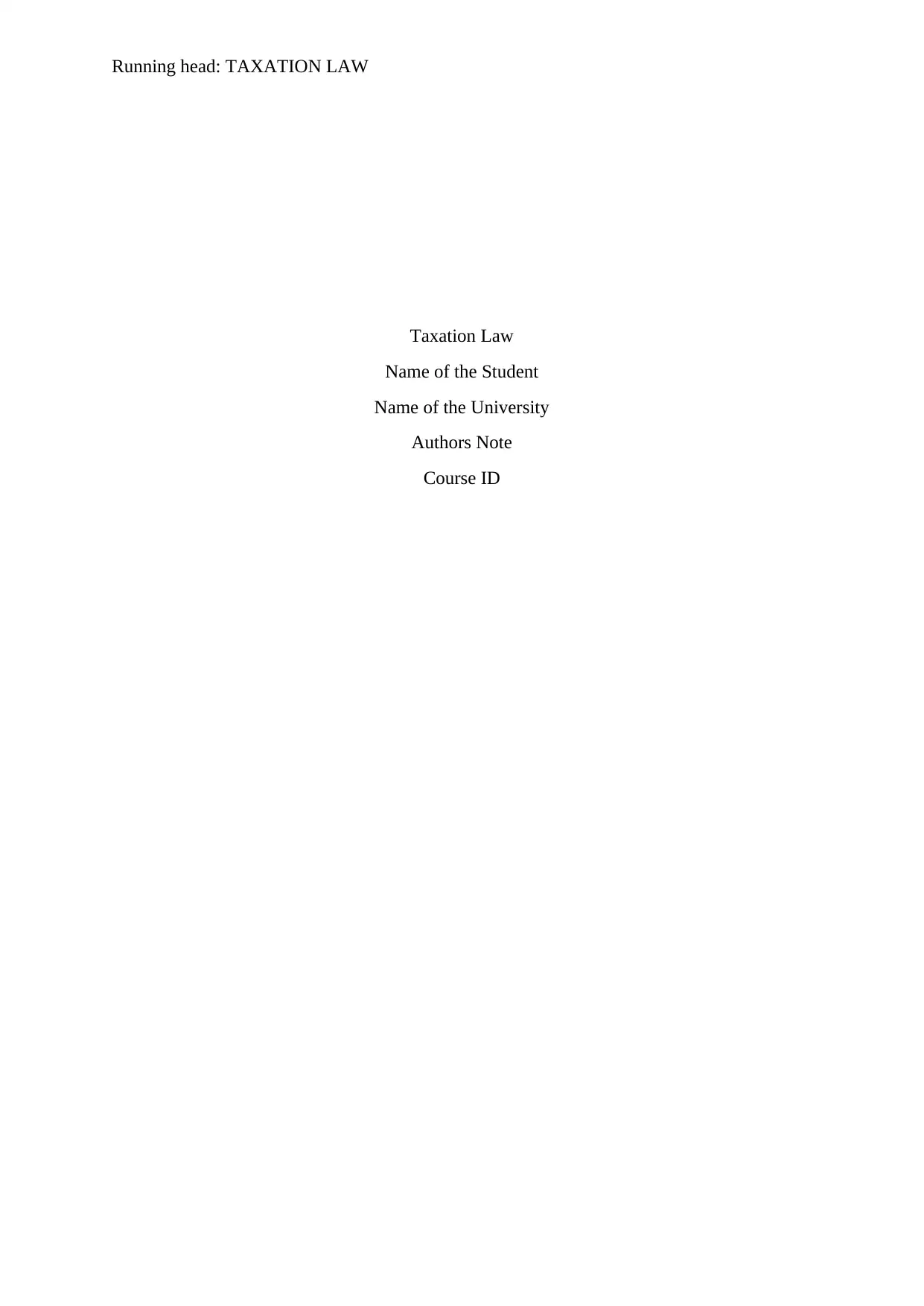
Running head: TAXATION LAW
Taxation Law
Name of the Student
Name of the University
Authors Note
Course ID
Taxation Law
Name of the Student
Name of the University
Authors Note
Course ID
Secure Best Marks with AI Grader
Need help grading? Try our AI Grader for instant feedback on your assignments.
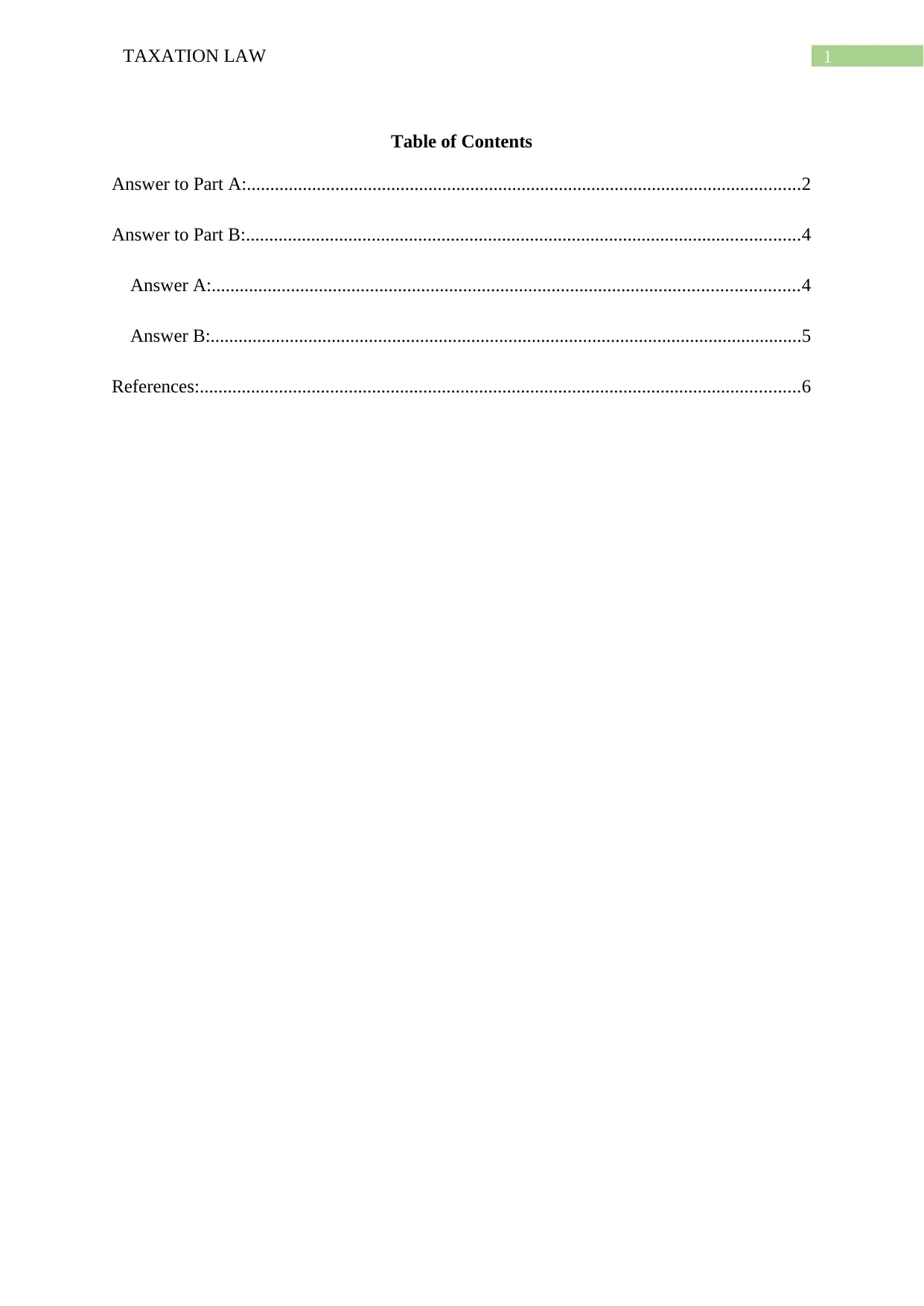
1TAXATION LAW
Table of Contents
Answer to Part A:.......................................................................................................................2
Answer to Part B:.......................................................................................................................4
Answer A:..............................................................................................................................4
Answer B:...............................................................................................................................5
References:.................................................................................................................................6
Table of Contents
Answer to Part A:.......................................................................................................................2
Answer to Part B:.......................................................................................................................4
Answer A:..............................................................................................................................4
Answer B:...............................................................................................................................5
References:.................................................................................................................................6
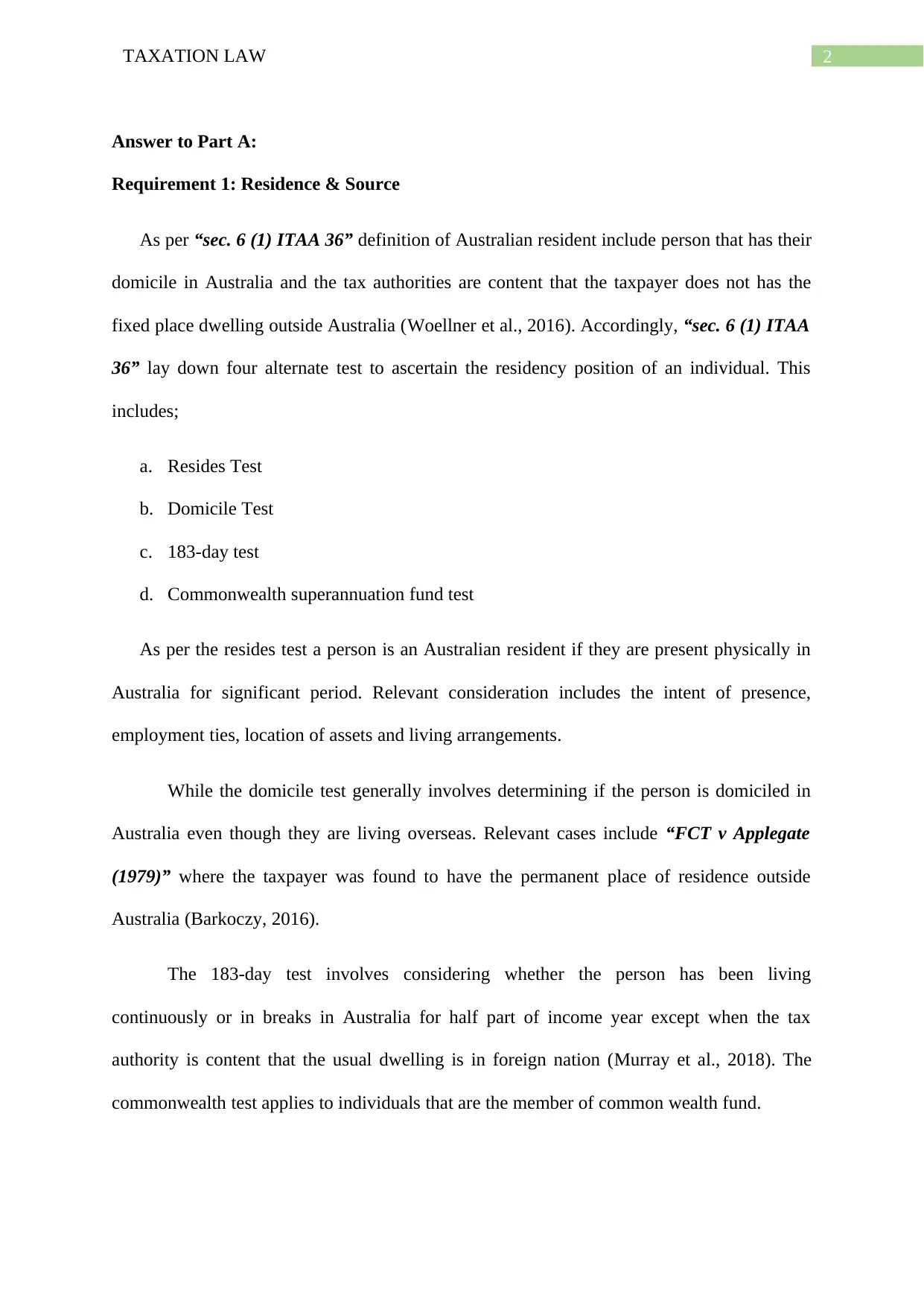
2TAXATION LAW
Answer to Part A:
Requirement 1: Residence & Source
As per “sec. 6 (1) ITAA 36” definition of Australian resident include person that has their
domicile in Australia and the tax authorities are content that the taxpayer does not has the
fixed place dwelling outside Australia (Woellner et al., 2016). Accordingly, “sec. 6 (1) ITAA
36” lay down four alternate test to ascertain the residency position of an individual. This
includes;
a. Resides Test
b. Domicile Test
c. 183-day test
d. Commonwealth superannuation fund test
As per the resides test a person is an Australian resident if they are present physically in
Australia for significant period. Relevant consideration includes the intent of presence,
employment ties, location of assets and living arrangements.
While the domicile test generally involves determining if the person is domiciled in
Australia even though they are living overseas. Relevant cases include “FCT v Applegate
(1979)” where the taxpayer was found to have the permanent place of residence outside
Australia (Barkoczy, 2016).
The 183-day test involves considering whether the person has been living
continuously or in breaks in Australia for half part of income year except when the tax
authority is content that the usual dwelling is in foreign nation (Murray et al., 2018). The
commonwealth test applies to individuals that are the member of common wealth fund.
Answer to Part A:
Requirement 1: Residence & Source
As per “sec. 6 (1) ITAA 36” definition of Australian resident include person that has their
domicile in Australia and the tax authorities are content that the taxpayer does not has the
fixed place dwelling outside Australia (Woellner et al., 2016). Accordingly, “sec. 6 (1) ITAA
36” lay down four alternate test to ascertain the residency position of an individual. This
includes;
a. Resides Test
b. Domicile Test
c. 183-day test
d. Commonwealth superannuation fund test
As per the resides test a person is an Australian resident if they are present physically in
Australia for significant period. Relevant consideration includes the intent of presence,
employment ties, location of assets and living arrangements.
While the domicile test generally involves determining if the person is domiciled in
Australia even though they are living overseas. Relevant cases include “FCT v Applegate
(1979)” where the taxpayer was found to have the permanent place of residence outside
Australia (Barkoczy, 2016).
The 183-day test involves considering whether the person has been living
continuously or in breaks in Australia for half part of income year except when the tax
authority is content that the usual dwelling is in foreign nation (Murray et al., 2018). The
commonwealth test applies to individuals that are the member of common wealth fund.
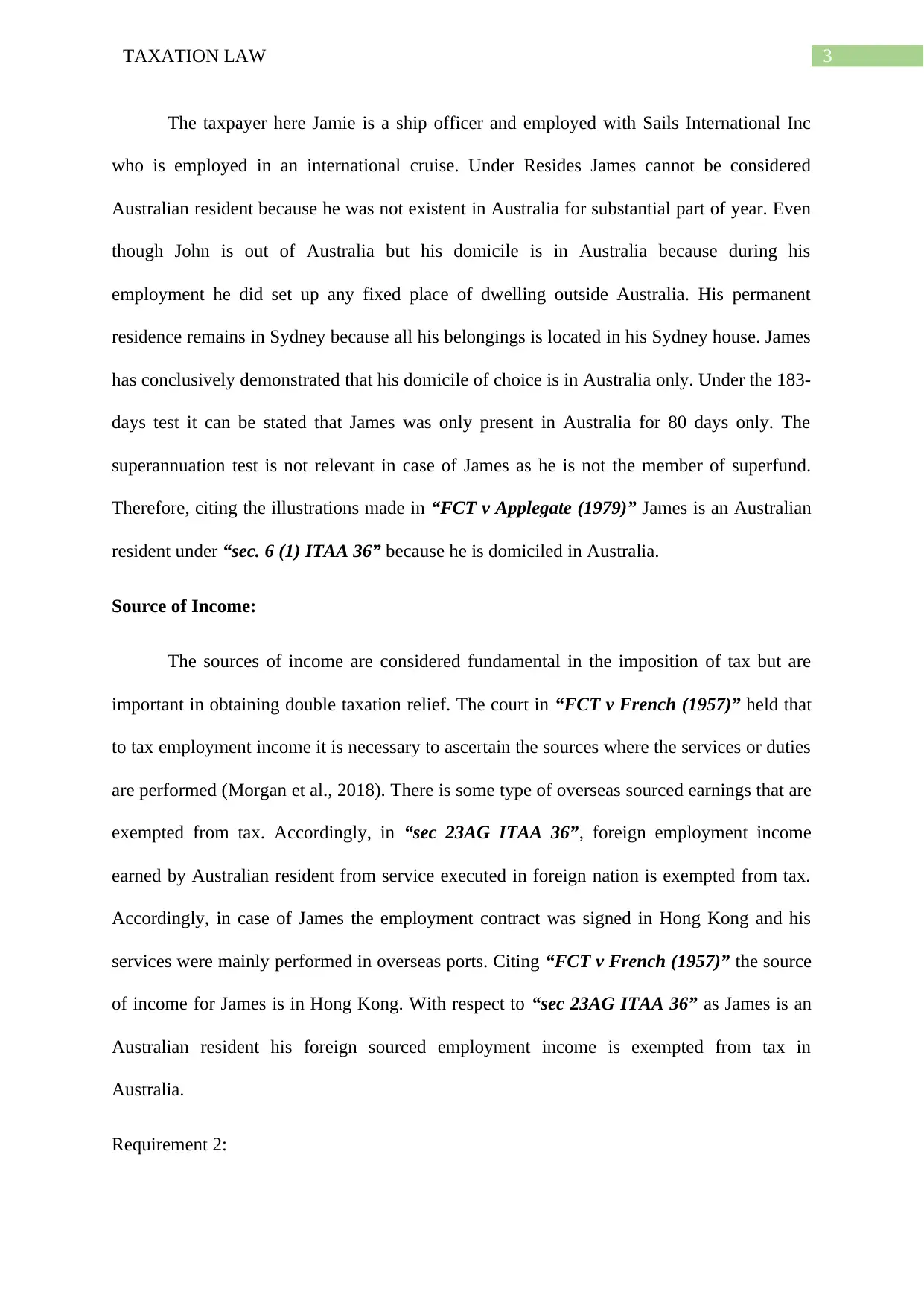
3TAXATION LAW
The taxpayer here Jamie is a ship officer and employed with Sails International Inc
who is employed in an international cruise. Under Resides James cannot be considered
Australian resident because he was not existent in Australia for substantial part of year. Even
though John is out of Australia but his domicile is in Australia because during his
employment he did set up any fixed place of dwelling outside Australia. His permanent
residence remains in Sydney because all his belongings is located in his Sydney house. James
has conclusively demonstrated that his domicile of choice is in Australia only. Under the 183-
days test it can be stated that James was only present in Australia for 80 days only. The
superannuation test is not relevant in case of James as he is not the member of superfund.
Therefore, citing the illustrations made in “FCT v Applegate (1979)” James is an Australian
resident under “sec. 6 (1) ITAA 36” because he is domiciled in Australia.
Source of Income:
The sources of income are considered fundamental in the imposition of tax but are
important in obtaining double taxation relief. The court in “FCT v French (1957)” held that
to tax employment income it is necessary to ascertain the sources where the services or duties
are performed (Morgan et al., 2018). There is some type of overseas sourced earnings that are
exempted from tax. Accordingly, in “sec 23AG ITAA 36”, foreign employment income
earned by Australian resident from service executed in foreign nation is exempted from tax.
Accordingly, in case of James the employment contract was signed in Hong Kong and his
services were mainly performed in overseas ports. Citing “FCT v French (1957)” the source
of income for James is in Hong Kong. With respect to “sec 23AG ITAA 36” as James is an
Australian resident his foreign sourced employment income is exempted from tax in
Australia.
Requirement 2:
The taxpayer here Jamie is a ship officer and employed with Sails International Inc
who is employed in an international cruise. Under Resides James cannot be considered
Australian resident because he was not existent in Australia for substantial part of year. Even
though John is out of Australia but his domicile is in Australia because during his
employment he did set up any fixed place of dwelling outside Australia. His permanent
residence remains in Sydney because all his belongings is located in his Sydney house. James
has conclusively demonstrated that his domicile of choice is in Australia only. Under the 183-
days test it can be stated that James was only present in Australia for 80 days only. The
superannuation test is not relevant in case of James as he is not the member of superfund.
Therefore, citing the illustrations made in “FCT v Applegate (1979)” James is an Australian
resident under “sec. 6 (1) ITAA 36” because he is domiciled in Australia.
Source of Income:
The sources of income are considered fundamental in the imposition of tax but are
important in obtaining double taxation relief. The court in “FCT v French (1957)” held that
to tax employment income it is necessary to ascertain the sources where the services or duties
are performed (Morgan et al., 2018). There is some type of overseas sourced earnings that are
exempted from tax. Accordingly, in “sec 23AG ITAA 36”, foreign employment income
earned by Australian resident from service executed in foreign nation is exempted from tax.
Accordingly, in case of James the employment contract was signed in Hong Kong and his
services were mainly performed in overseas ports. Citing “FCT v French (1957)” the source
of income for James is in Hong Kong. With respect to “sec 23AG ITAA 36” as James is an
Australian resident his foreign sourced employment income is exempted from tax in
Australia.
Requirement 2:
Secure Best Marks with AI Grader
Need help grading? Try our AI Grader for instant feedback on your assignments.
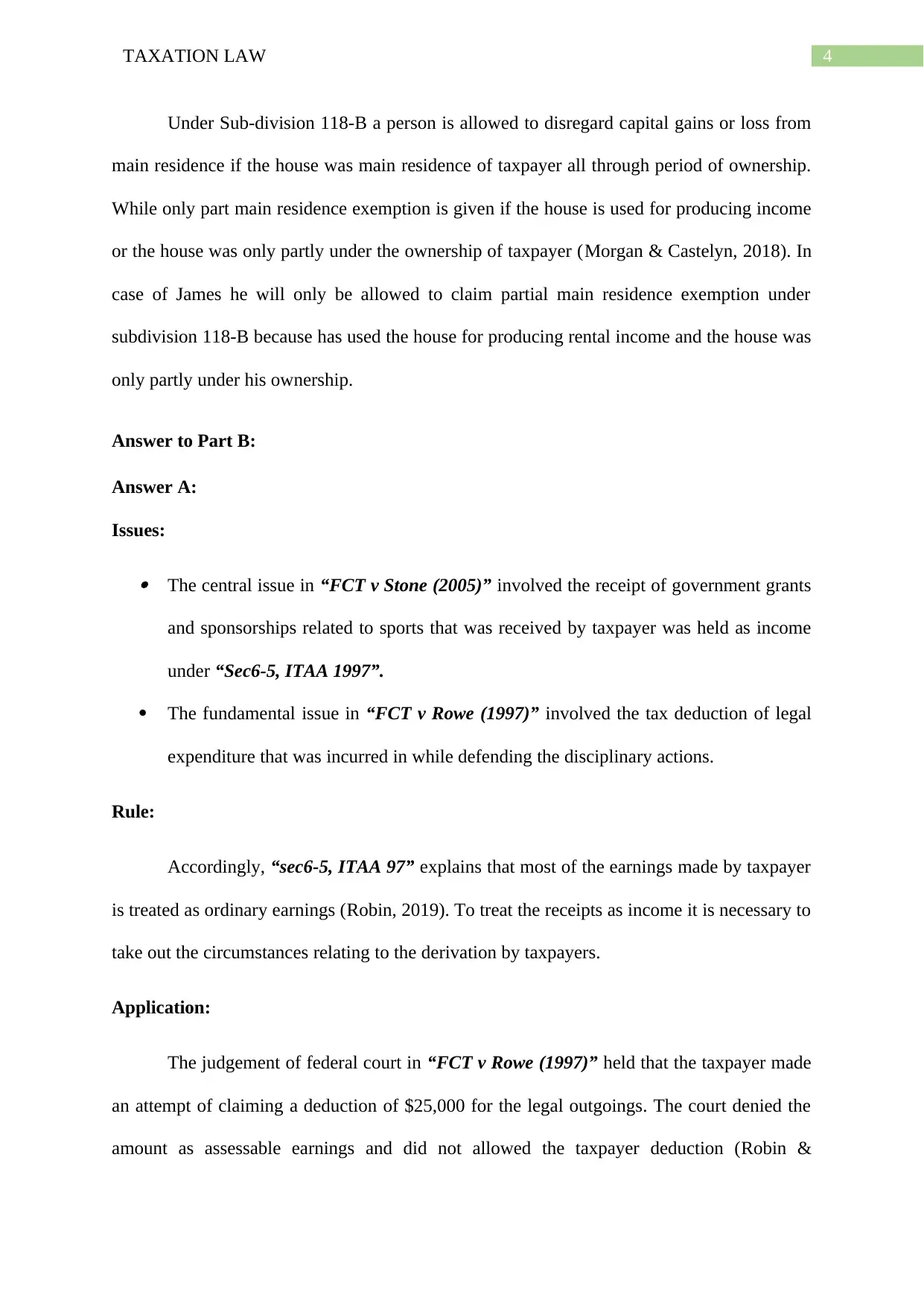
4TAXATION LAW
Under Sub-division 118-B a person is allowed to disregard capital gains or loss from
main residence if the house was main residence of taxpayer all through period of ownership.
While only part main residence exemption is given if the house is used for producing income
or the house was only partly under the ownership of taxpayer (Morgan & Castelyn, 2018). In
case of James he will only be allowed to claim partial main residence exemption under
subdivision 118-B because has used the house for producing rental income and the house was
only partly under his ownership.
Answer to Part B:
Answer A:
Issues:
The central issue in “FCT v Stone (2005)” involved the receipt of government grants
and sponsorships related to sports that was received by taxpayer was held as income
under “Sec6-5, ITAA 1997”.
The fundamental issue in “FCT v Rowe (1997)” involved the tax deduction of legal
expenditure that was incurred in while defending the disciplinary actions.
Rule:
Accordingly, “sec6-5, ITAA 97” explains that most of the earnings made by taxpayer
is treated as ordinary earnings (Robin, 2019). To treat the receipts as income it is necessary to
take out the circumstances relating to the derivation by taxpayers.
Application:
The judgement of federal court in “FCT v Rowe (1997)” held that the taxpayer made
an attempt of claiming a deduction of $25,000 for the legal outgoings. The court denied the
amount as assessable earnings and did not allowed the taxpayer deduction (Robin &
Under Sub-division 118-B a person is allowed to disregard capital gains or loss from
main residence if the house was main residence of taxpayer all through period of ownership.
While only part main residence exemption is given if the house is used for producing income
or the house was only partly under the ownership of taxpayer (Morgan & Castelyn, 2018). In
case of James he will only be allowed to claim partial main residence exemption under
subdivision 118-B because has used the house for producing rental income and the house was
only partly under his ownership.
Answer to Part B:
Answer A:
Issues:
The central issue in “FCT v Stone (2005)” involved the receipt of government grants
and sponsorships related to sports that was received by taxpayer was held as income
under “Sec6-5, ITAA 1997”.
The fundamental issue in “FCT v Rowe (1997)” involved the tax deduction of legal
expenditure that was incurred in while defending the disciplinary actions.
Rule:
Accordingly, “sec6-5, ITAA 97” explains that most of the earnings made by taxpayer
is treated as ordinary earnings (Robin, 2019). To treat the receipts as income it is necessary to
take out the circumstances relating to the derivation by taxpayers.
Application:
The judgement of federal court in “FCT v Rowe (1997)” held that the taxpayer made
an attempt of claiming a deduction of $25,000 for the legal outgoings. The court denied the
amount as assessable earnings and did not allowed the taxpayer deduction (Robin &
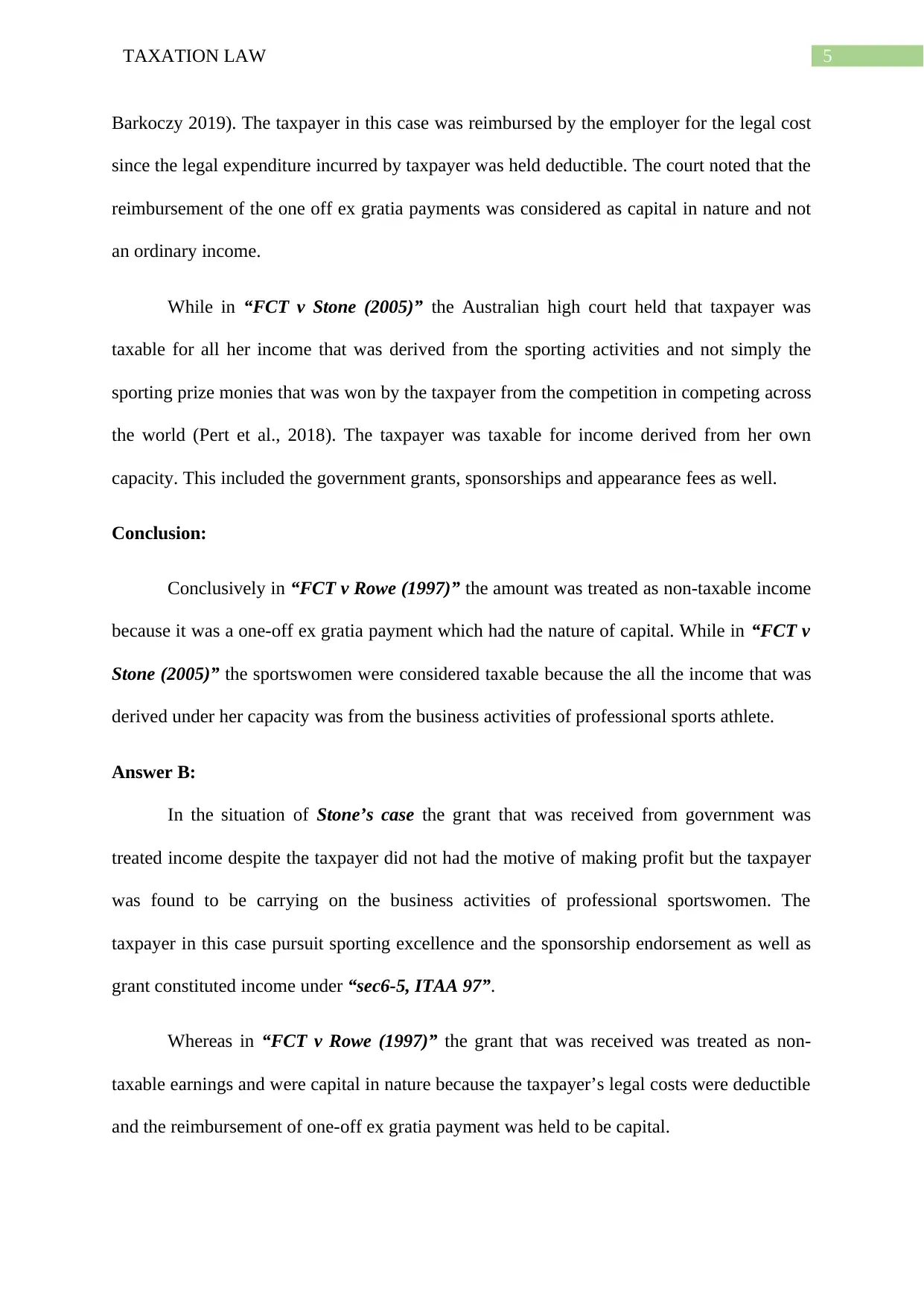
5TAXATION LAW
Barkoczy 2019). The taxpayer in this case was reimbursed by the employer for the legal cost
since the legal expenditure incurred by taxpayer was held deductible. The court noted that the
reimbursement of the one off ex gratia payments was considered as capital in nature and not
an ordinary income.
While in “FCT v Stone (2005)” the Australian high court held that taxpayer was
taxable for all her income that was derived from the sporting activities and not simply the
sporting prize monies that was won by the taxpayer from the competition in competing across
the world (Pert et al., 2018). The taxpayer was taxable for income derived from her own
capacity. This included the government grants, sponsorships and appearance fees as well.
Conclusion:
Conclusively in “FCT v Rowe (1997)” the amount was treated as non-taxable income
because it was a one-off ex gratia payment which had the nature of capital. While in “FCT v
Stone (2005)” the sportswomen were considered taxable because the all the income that was
derived under her capacity was from the business activities of professional sports athlete.
Answer B:
In the situation of Stone’s case the grant that was received from government was
treated income despite the taxpayer did not had the motive of making profit but the taxpayer
was found to be carrying on the business activities of professional sportswomen. The
taxpayer in this case pursuit sporting excellence and the sponsorship endorsement as well as
grant constituted income under “sec6-5, ITAA 97”.
Whereas in “FCT v Rowe (1997)” the grant that was received was treated as non-
taxable earnings and were capital in nature because the taxpayer’s legal costs were deductible
and the reimbursement of one-off ex gratia payment was held to be capital.
Barkoczy 2019). The taxpayer in this case was reimbursed by the employer for the legal cost
since the legal expenditure incurred by taxpayer was held deductible. The court noted that the
reimbursement of the one off ex gratia payments was considered as capital in nature and not
an ordinary income.
While in “FCT v Stone (2005)” the Australian high court held that taxpayer was
taxable for all her income that was derived from the sporting activities and not simply the
sporting prize monies that was won by the taxpayer from the competition in competing across
the world (Pert et al., 2018). The taxpayer was taxable for income derived from her own
capacity. This included the government grants, sponsorships and appearance fees as well.
Conclusion:
Conclusively in “FCT v Rowe (1997)” the amount was treated as non-taxable income
because it was a one-off ex gratia payment which had the nature of capital. While in “FCT v
Stone (2005)” the sportswomen were considered taxable because the all the income that was
derived under her capacity was from the business activities of professional sports athlete.
Answer B:
In the situation of Stone’s case the grant that was received from government was
treated income despite the taxpayer did not had the motive of making profit but the taxpayer
was found to be carrying on the business activities of professional sportswomen. The
taxpayer in this case pursuit sporting excellence and the sponsorship endorsement as well as
grant constituted income under “sec6-5, ITAA 97”.
Whereas in “FCT v Rowe (1997)” the grant that was received was treated as non-
taxable earnings and were capital in nature because the taxpayer’s legal costs were deductible
and the reimbursement of one-off ex gratia payment was held to be capital.
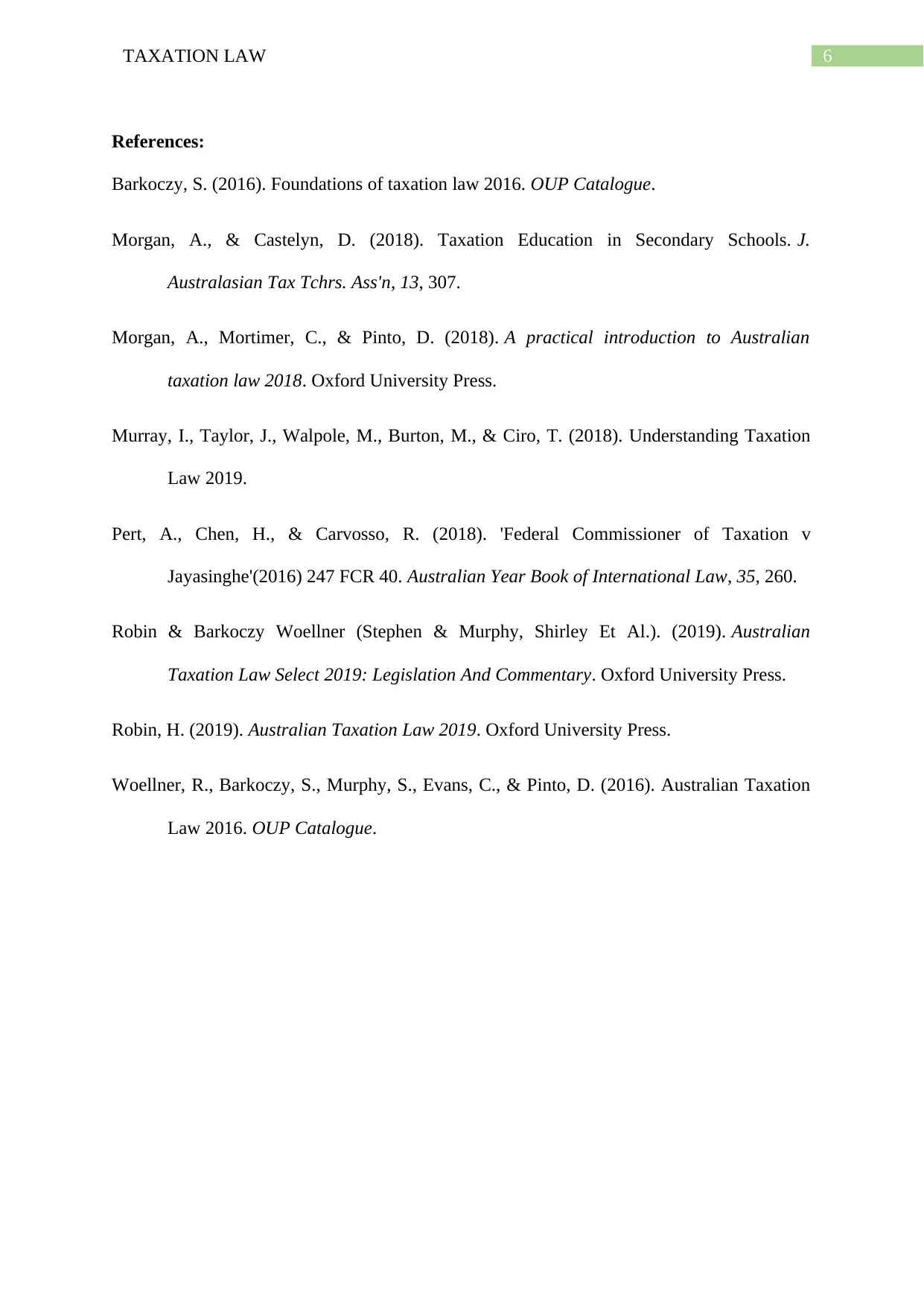
6TAXATION LAW
References:
Barkoczy, S. (2016). Foundations of taxation law 2016. OUP Catalogue.
Morgan, A., & Castelyn, D. (2018). Taxation Education in Secondary Schools. J.
Australasian Tax Tchrs. Ass'n, 13, 307.
Morgan, A., Mortimer, C., & Pinto, D. (2018). A practical introduction to Australian
taxation law 2018. Oxford University Press.
Murray, I., Taylor, J., Walpole, M., Burton, M., & Ciro, T. (2018). Understanding Taxation
Law 2019.
Pert, A., Chen, H., & Carvosso, R. (2018). 'Federal Commissioner of Taxation v
Jayasinghe'(2016) 247 FCR 40. Australian Year Book of International Law, 35, 260.
Robin & Barkoczy Woellner (Stephen & Murphy, Shirley Et Al.). (2019). Australian
Taxation Law Select 2019: Legislation And Commentary. Oxford University Press.
Robin, H. (2019). Australian Taxation Law 2019. Oxford University Press.
Woellner, R., Barkoczy, S., Murphy, S., Evans, C., & Pinto, D. (2016). Australian Taxation
Law 2016. OUP Catalogue.
References:
Barkoczy, S. (2016). Foundations of taxation law 2016. OUP Catalogue.
Morgan, A., & Castelyn, D. (2018). Taxation Education in Secondary Schools. J.
Australasian Tax Tchrs. Ass'n, 13, 307.
Morgan, A., Mortimer, C., & Pinto, D. (2018). A practical introduction to Australian
taxation law 2018. Oxford University Press.
Murray, I., Taylor, J., Walpole, M., Burton, M., & Ciro, T. (2018). Understanding Taxation
Law 2019.
Pert, A., Chen, H., & Carvosso, R. (2018). 'Federal Commissioner of Taxation v
Jayasinghe'(2016) 247 FCR 40. Australian Year Book of International Law, 35, 260.
Robin & Barkoczy Woellner (Stephen & Murphy, Shirley Et Al.). (2019). Australian
Taxation Law Select 2019: Legislation And Commentary. Oxford University Press.
Robin, H. (2019). Australian Taxation Law 2019. Oxford University Press.
Woellner, R., Barkoczy, S., Murphy, S., Evans, C., & Pinto, D. (2016). Australian Taxation
Law 2016. OUP Catalogue.
1 out of 7
Related Documents
Your All-in-One AI-Powered Toolkit for Academic Success.
+13062052269
info@desklib.com
Available 24*7 on WhatsApp / Email
![[object Object]](/_next/static/media/star-bottom.7253800d.svg)
Unlock your academic potential
© 2024 | Zucol Services PVT LTD | All rights reserved.





